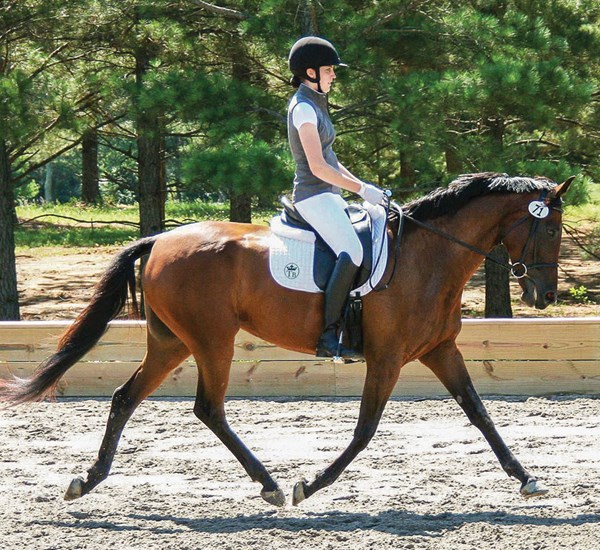
This picture shows Keena Mullen competing her 11-year-old Thoroughbred mare, Yes Virginia, in First Level, Test 3. At this moment, she is lengthening her horse’s stride in trot. “Ginny,” as Keena fondly calls her mare, has been competing very successfully during the last season and is now entering Second Level and schooling Third Level movements.
Training a Thoroughbred in dressage can be a very rewarding experience. They are known to be sensible, sensitive and willing to move forward. Ginny shows lovely activity in her hindquarters during this lengthening of the trot. Personally, I prefer this to a flashy front leg with no connection from behind. You can really see in this picture how much she is bending in her hip joint and croup so the energy from her engine behind can help move her shoulders forward. As Keena and Ginny keep progressing, work at Second and Third Levels will require that the shoulders come up a bit higher and allow more freedom of the forehand and more self-carriage.
The first impression I have when looking at Keena is that she is sitting very correctly. This made me think twice about what I could possibly write about her and what tips I could offer. The outline of her seat is correct and I particularly like the line of her hand to the rein and to her horse’s mouth. You can really draw a straight line from her elbow to the bit.
Zooming in on the picture, I noticed one thing that I can criticize. From afar, I initially thought that there was just white foam on Ginny’s mouth. But I noticed that it is actually a bit open and it looks dry. The slightly open mouth can be just a moment in time that the photograph captures, and in which case, this point is hardly relevant. However, if it is visible over a longer period of steps, it hints that the horse is not fully supple in her neck and jaw, as a true neck bend would activate a gland that produces more saliva, making the horse’s mouth foam up. This can actually be noticed even when riders choose to use a bitless bridle.
This made me look closer at Keena’s balance during the lengthened strides. I drew a line vertically up through her hip joint and another straight line connecting her hip joint with her shoulder, ear and ankle joint. As I looked at this line, it became apparent that Keena is sitting very slightly behind the vertical line.
Unfortunately, finding correct balance is a bit like shooting a gun or arrow at a target. A millimeter next to the goal is still considered a full miss! This means that in this moment, Keena is not fully in balance and her slightly sitting behind the vertical could be the cause of this moment of resistance in her mare’s mouth. This does not mean that Keena is hanging on the reins or pulling, but it does mean that for a short moment her balance is lost and needs refining.
In more extreme scenarios, some riders, especially in the extended moments, lean their upper body back and push. This forces the horse onto the forehand. However in Keena’s case, it looks to me like she got left behind the motion for a split second. I can also see that her seat has slid back in the saddle a bit, her leg has slightly come up and she is not sitting as deep as she could be.
To be able to support Ginny even better during extensions I would advise Keena to try this: Think of stretching your upper body taller and longer while stretching your legs longer at the same time. This gives your body more stability to follow the horse’s movement.
To understand upper-body balance better the following comparison can be helpful: Think about the picture of a rider’s upper-body. As the rider connects with the horse through the pelvis, the horse’s movement will move the pelvis forward. If I were to stand on a skateboard and it started moving, I probably would find myself sitting on the floor while the skateboard took off because I did not naturally follow the forward motion with my body. Imagine that the saddle is like the skateboard. It will move your pelvis but you have to bring your chest in the direction of the movement or you will be immediately left behind. Just a very slight (few millimeters) aligning of her upper body into the forward movement combined with length through her whole body will help Keena sit with a lighter contact and a more supple connection during the extensions. As they refine some details, I am sure that Keena and Ginny will enjoy their journey up through the levels.
Susanne von Dietze is a leader in equestrian biomechanics. A physiotherapist, licensed Trainer A instructor and judge for dressage and show jumping, she gives lectures and seminars throughout the world, including at the prestigious German Riding Academy in Warendorf. She is a native of Germany and now lives with her husband and three children in Israel, where she competes at the international level. She is the author of two books on the biomechanics of riding: Balance in Movement and Horse and Rider, Back to Back. Find her books at www.EquineNetworkStore.com.











